

Originally posted April 17, 2016
This week we'll be having a look into the world of classic percussion-fired revolvers. The main player is a modern reproduction of a Colt 1851 Navy revolver... sort of.
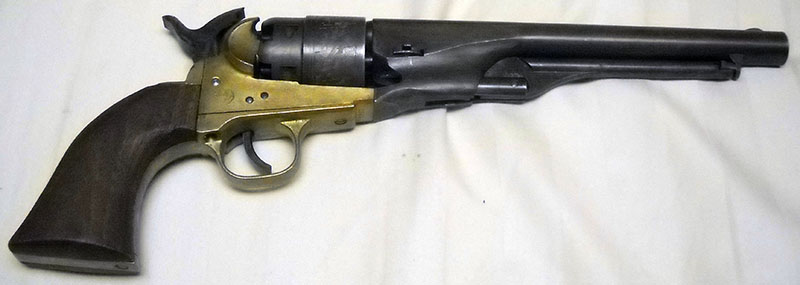
I say "sort of" because this reproduction has some significant differences from the real thing, but some background information is in order before we get into that.
Colt's Patent Fire Arms Manufacturing Company was founded in 1855 by the notorious Samuel Colt, who did not invent the revolver as a concept, but developed one of the first practical designs for one, and in the classic style of 19th-century inventors, was perfectly glad to take credit for the whole idea for most of his life.
The sharp-eyed reader will have noticed something odd above, namely, that the Colt company was founded in 1855 and the revolver we're looking at is a reproduction of an 1851 Colt. This is because Colt was a talented marketer-slash-huckster, but, again like many other famous inventors, he was not a terrific businessman. He was persistent, though, and canny about keeping hold of his patents, so he was able to keep trying, and his flair for PR coupled with the quality and competitive pricing of his products did eventually see him through to the kind of success and fame he ultimately enjoyed.
A bit wackily, the 1851 Navy was an enlarged version of a reduced version of an earlier design. Colt's first revolvers, in the 1830s, were large, ungainly things with features that would tend to strike one as odd today (for instance, the original Colt Paterson revolvers didn't have trigger guards, or indeed triggers as we know them today, instead featuring a peculiar retractable gizmo that only appeared when the hammer was cocked). The first one that followed what would become the "typical" Colt pattern was the 1847 Walker Colt, which was developed in collaboration with a man named Samuel Walker for the use of the organization Walker belonged to, the Texas Rangers.
(Yes, that's right. Colt developed a revolver for the use of a Texas Ranger named Walker.)
The Walker Colt was a behemoth of a pistol, well over a foot long and weighing in at a decidedly hefty four and a half pounds. It had a .44-caliber barrel and a disconcerting habit of exploding, on account of its oversized chambers, which were (a bit unfortunately) designed to hold more black powder than they could safely contain—about twice as much as other contemporary pistol' chambers. Walker was killed later that same year (not by an exploding revolver), and the following year Colt came out with the strengthened and improved Dragoon revolver, which was a little bit lighter, a little bit shorter, but still enormous and somewhat unruly. Colt shortened the cylinder slightly to prevent users from overstuffing the chambers, shortened the barrel a little, and... well, that was basically it.
There was also a much-scaled-down .31-caliber version of the Dragoon called, imaginatively, the Baby Dragoon, and presently this evolved into the 1849 Pocket Model, a nicely compact five-shooter that incorporated lessons learned in the development of the Dragoon. Then—this may be a little confusing, but it's how this kind of thing often works—Colt scaled the 1849 Pocket Model back up to create the .36-caliber 1851 Navy, and in doing so finally hit the sweet spot in terms of size and handiness. General-purpose revolvers would remain more or less the size of the 1851 Navy for the next fifty years or more.
The references to "Army" and "Navy" in the names of several mid-19th-century Colt revolvers can be a little puzzling to modern eyes, because these were not officially adopted by any branch of the United States military. As far as I know, the US military didn't really have much to do with handguns in those days; you would be issued a rifle, but if you wanted a pistol, you were on your own. For reasons which are obscure to me, however, it became semi-standard in the industry to refer to .36 as the "Navy caliber" and .44 as the "Army" caliber. This may have started with the fact that 1851 Colt Navy revolvers' cylinders were roll-engraved with a depiction of a naval battle; I'm not sure about that.
At any rate, the 1851 Navy was such a strong seller for Colt that even the development of metallic cartridges in the 1860s couldn't put it out to pasture until 1873, when Colt brought out the instant-classic Single Action Army, aka the "Peacemaker", aka the gun that basically everyone in Western movies is carrying. The 1860 Army model was basically the 1851 Navy with a round barrel instead of an octagonal one, and a step added to its frame, so that the larger-diameter cylinder required by switching from .36 to .44 caliber could be accommodated. (Meanwhile, the Pocket Model got a similar frame step so that its bore could be upsized from .31 to .36.)
Which brings us neatly back around to what I was saying earlier about my pistol sort of being a reproduction of an 1851 Navy. It was made by a company called Connecticut Valley Arms, and it's clearly supposed to be an 1851 Navy; it was labeled as such in its original packaging, and it has the naval-battle roll engraving on the cylinder. (The 1849 Pocket Model, incidentally, features instead a cheery little scene that appears to depict a stagecoach robbery.) Have another look at the photo, though, in the light of what I've said above, and you may notice that it has certain features not found on that model, but in fact taken from the 1860 Army: the barrel is round, with a smooth curve machined into it where it meets the cylinder, and the cylinder is visibly oversized, with a step cut into the frame to accommodate it. Despite being marked and sold as an 1851 Navy repro, this revolver is "Army-caliber"—that is, a .44.
I'm not sure why CVA chose to do that. It might have been done deliberately to prevent anyone from being able to pass one of these off as a genuine antique, or perhaps it was simply someone at the company deciding to do a little cheerful mashing-up of mid-1800s Colt design features. Identification-wise, I would think the markings do a pretty good job.
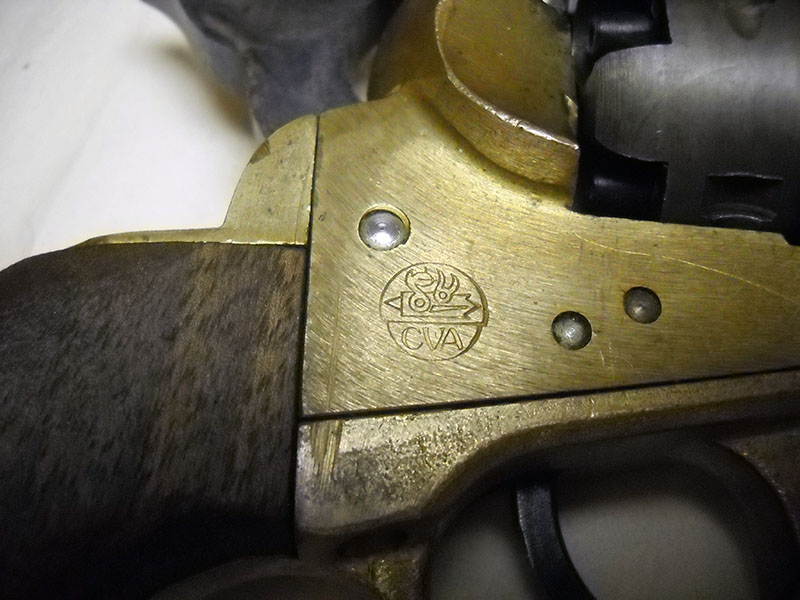

As it happens, I also have a nice Italian-made repro of an 1849 Pocket Model Colt; here they are together, which nicely illustrates both the marked similarities of their designs and the difference in scale.
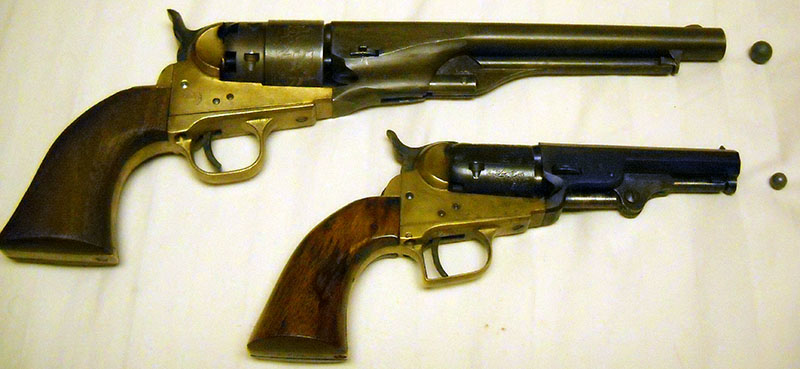
Those .31-caliber balls look pretty puny, but trust me, you really didn't want to get shot with one, particularly in the days before medical hygiene and antibiotics.
With the history taken care of, let's get a closer look at how this weapon works. Like all Colt revolvers (and indeed most revolvers generally) of its day, the 1851 Navy has a single-action trigger, which we've talked about before. The hammer has to be pulled back to the full cock position before the trigger will actually do anything. In the first picture above, it's shown at half cock, which is the position at which the cylinder is free to turn and the pistol can be loaded and capped.
Loading was a long and arduous process in any pre-cartridge firearm, and for repeating arms like Colt's revolvers, it took five or six times as long, since each chamber had to be loaded individually, by hand. It involves as much paraphernalia as one of the more complicated illicit drugs and is just about as ritualistic.
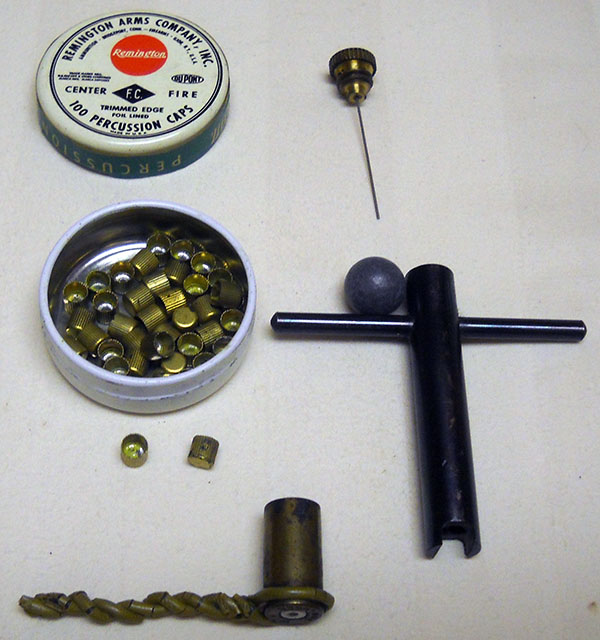
Here we have the gubbins you need to load one of these pistols, less the actual gunpowder. Clockwise from the top left we have:
Here's what you have to do:
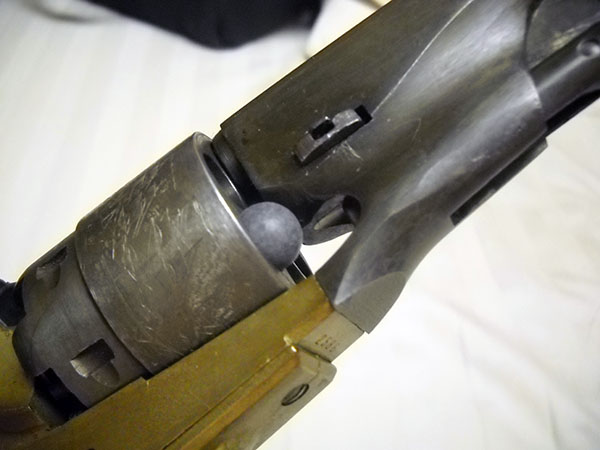
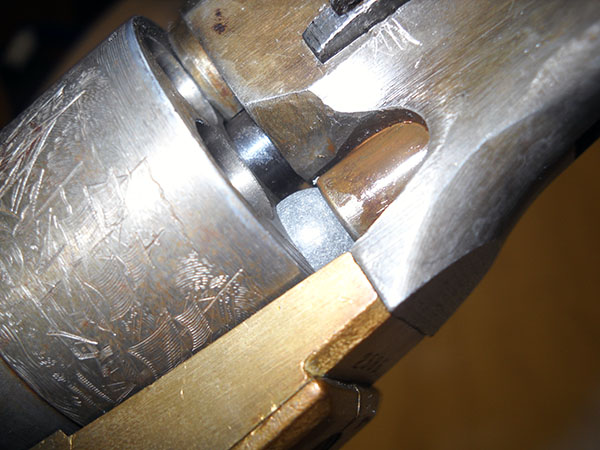
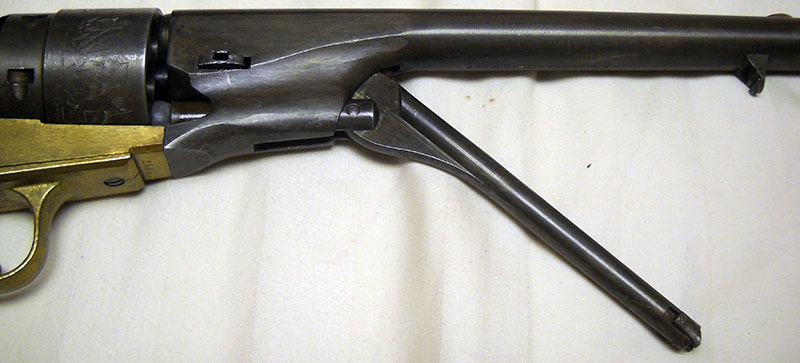
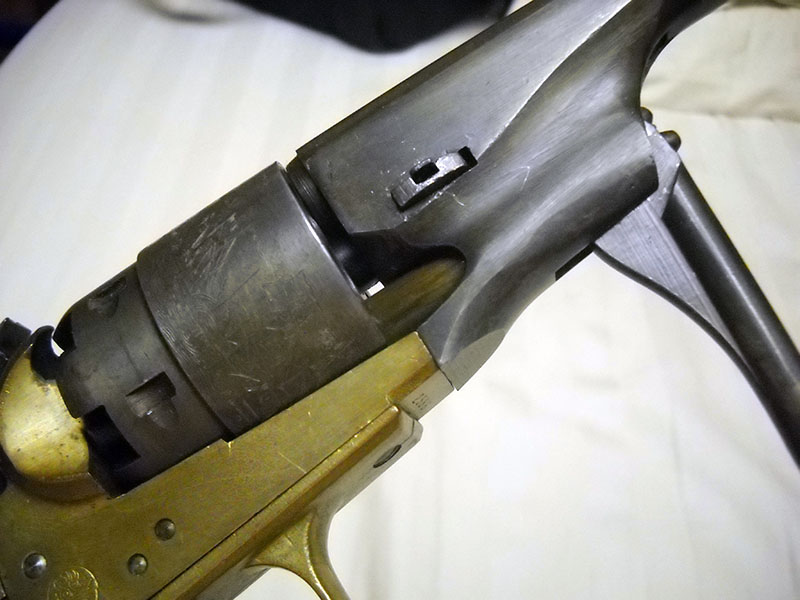
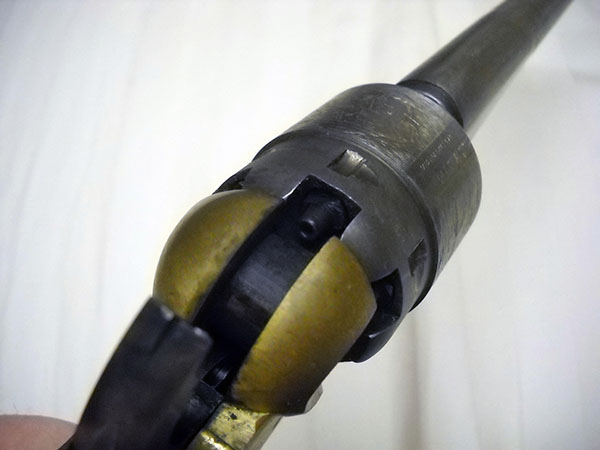
As is always the case with old single-action revolvers, if (for some reason) you're planning to carry it loaded, you should leave a chamber empty, or at the very least uncapped, and carry it with the hammer down on that one. Some can be jiggered so that the hammer is down on the blank space between two of the nipples, but this isn't something most were designed to do and they can't be relied on to index properly when cocked from that condition. Some will, some won't, and some will do it some of the time. This is probably pointless advice, since it's unlikely anyone here is going to have cause to carry a loaded cap-and-ball revolver around, but in the interest of completeness, a reminder.
The metal pick shown in the paraphernalia photo is for cleaning crud out of the flash holes, which can build up and eventually stop the chambers from firing. Mine is threaded so it stores in the end of the nipple wrench when not in use. The nipples are screwed into the cylinder and can be taken out with said wrench for more comprehensive cleaning, or to be replaced. With heavy use they will eventually flatten out and become too short for the hammer to hit them reliably, too wide to get a cap on, or both.
Cap-and-ball firearms have certain disadvantages, to be sure. For one, the cap is vulnerable to being set off when you don't want it to, if you should, for example, drop the gun so that it lands at the wrong angle on a hard surface. For another, as previously noted, the nipples can get gunked up or deformed by outside forces and rendered inoperative. They're so much easier to use and more reliable than flintlock ignition, though, that they were the dominant igition system for firearms for more than half of the 19th century. (In hindsight, the percussion cap is a pretty obvious precursor to the centerfire cartridge primer, but it still took a few decades for that concept to catch on.)
As an aside, another of the several annoying problems with the Walker (although ranking somewhere below "it blows up sometimes") is that it had the first version of the loading lever on it, and it wasn't quite designed right. Under recoil, it had a habit of unlatching and flopping down, causing the loading piston to jam up the cylinder. On the Dragoon and subsequent models, Colt fixed the way it's secured when not in use, fitting it with this nice spring-loaded catch.
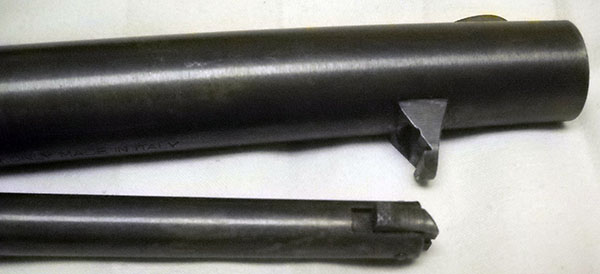
That solved the problem.
The key feature of the Colt system—what set it apart from most of its competitors at the time and set the standard for how revolvers would work thereafter—is the mechanism it used to advance the cylinder for the next shot. This is called indexing, and in early multi-chamber repeaters it had to be done by hand. The shooter would have to unlock the mechanism somehow and either rotate the cylinder or slide the bar (vertical or horizontal multi-chamber bar repeaters were a thing for a while, and were just as unwieldy as you're imagining now) so that the next chamber lined up with the barrel, then lock it all down again and fire. That was a hassle and was easy to line up wrong, with a variety of unfortune consequences ranging from failure to fire to blowing up the gun.
In a Colt revolver, there is a mechanism built into the trigger lockwork that indexes the cylinder automatically, and, if it's working right, precisely. It also prevents the cylinder from moving again until the right point in the process. It has two key parts, and this is how it works.
On the sides of the cylinder, there are notches corresponding to each of the chambers.
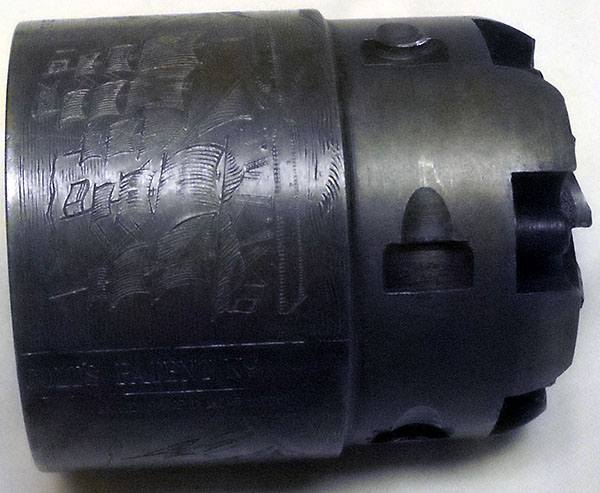
(In this view, you can also get a look at the naval-battle roll engraving, and the 1860 Army-style rebate to accommodate the 44-caliber chambers is quite obvious. The original .36-caliber cylinders were the same diameter all the way back.)
Meanwhile, at the back of the cylinder, there is a geartooth-like arrangement around the hole for the cylinder pin.
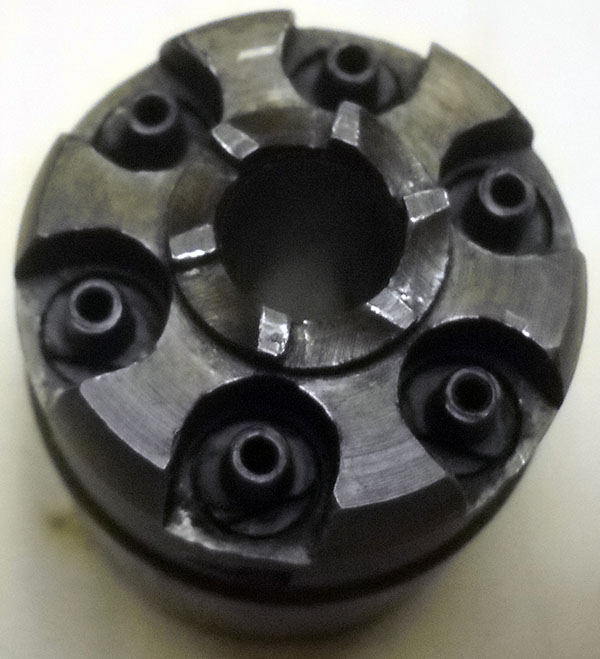
These teeth interact with a small mechanism in the frame of the pistol, known as the hand, which is actuated by the hammer. Pull the hammer back to half-cock, and the hand disengages, allowing the cylinder to rotate:
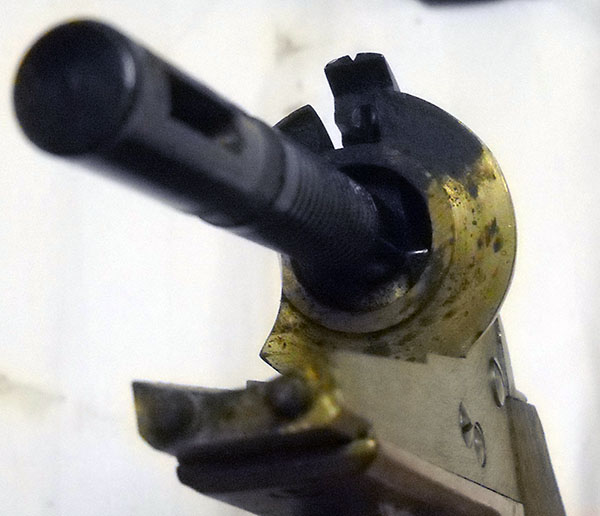
(You can see it there to the right, that is the shooter's left, of the cylinder pin. And yes, I really need to get some proper solvent and clean the frame; that's what it looks like after a basic post-shooting wipedown without taking it apart.)
When the hammer is pulled back to full cock, the hand moves slightly forward and up, engaging the teeth and rotating the cylinder into position for firing. Colt revolvers turn clockwise from the shooter's perspective.
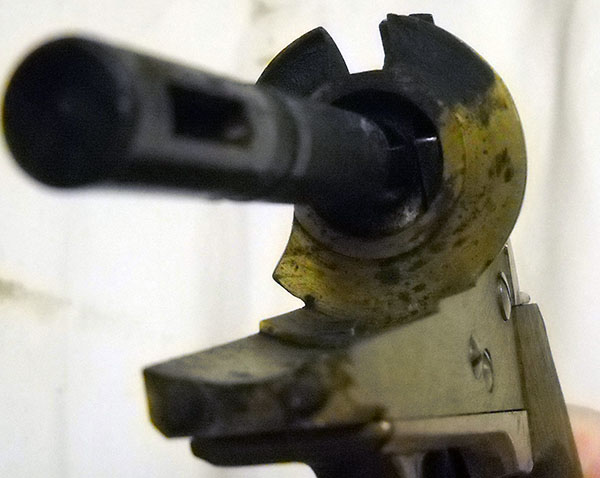
While all this is going on, another bit of the same mechanism, imaginatively called the cylinder lock, is at work on those notches in the side of the cylinder. It's down in the bottom of the frame, and looks like this.
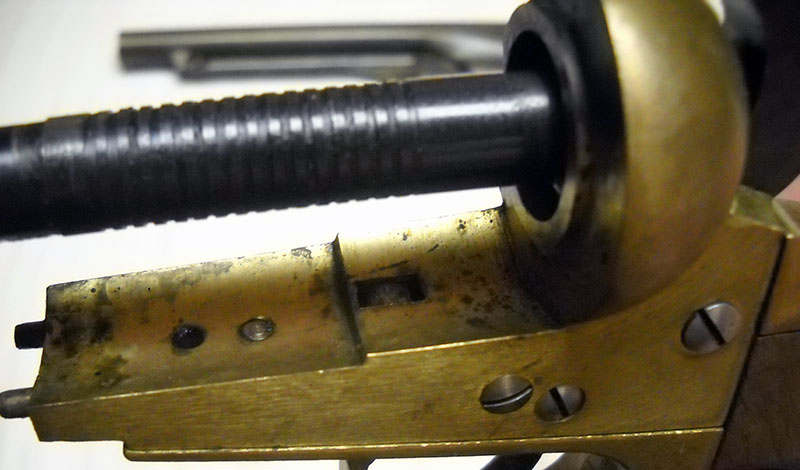
Shown here at half-cock, that nub just behind the step in the frame is retracted, so that it does not interfere with the cylinder's rotation. At full cock, it pops up and engages with the notch at the bottom of the cylinder (which has that sloping relief cut in it so that the cylinder lock acts as a ratchet: the cylinder can keep rotating until it reaches the proper position, then stops).
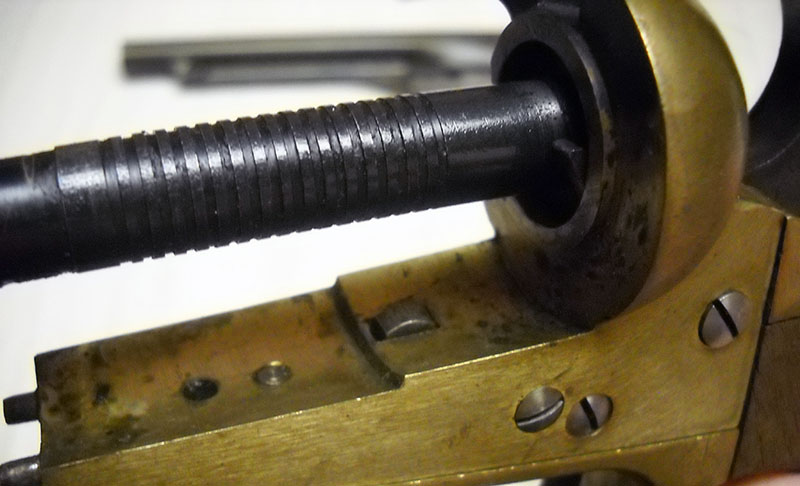
Both of these are quite small movements, but they're enough to provide positive, reliable function, and since the minute Colt's patents on them expired, they've been how (with variations in the position and shape of the bits) revolvers have worked ever since. I should note that both of these mechanisms are worked only by drawing the hammer back; when it drops for firing, neither one moves, ensuring that the cylinder stays locked in place. It can't advance further because of the cylinder stop, and it can't go back because of the hand. It's a pretty elegant system.
Might as well take a look at the front of the cylinder too, while we're here. There's not much to see, but I did manage to orient it so that you can see light through a couple of the flash holes.
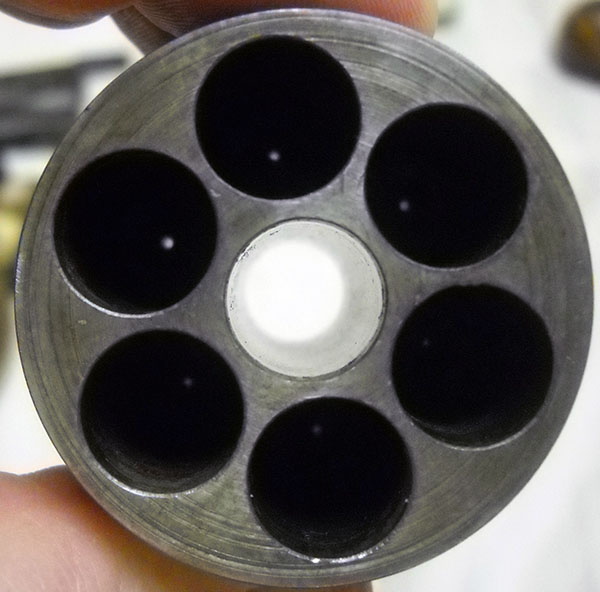
Here's a somewhat less definitive feature of early Colt revolvers: the sighting system. The front sight is a short blade out at the muzzle, as you might expect, but the rear sight...
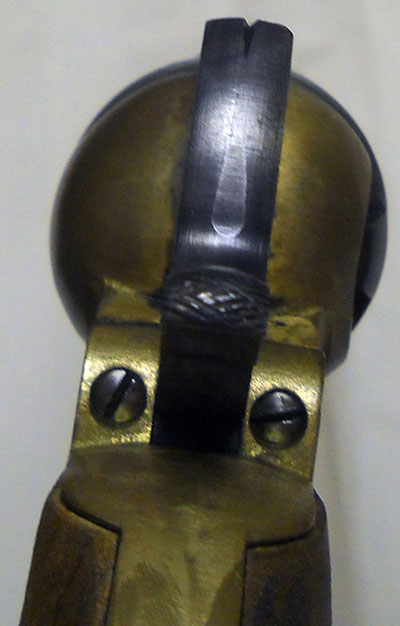
... is a notch cut into the hammer.
One the one hand, this is kind of an ingenious thing to do, because if you line up a shot and the pistol isn't cocked, you know it immediately. On the other hand, putting part of the sighting system on a moving part is not really ever going to be a great idea. Then again, shooting practices were different in those days, and a lot of people didn't bother with the sights very often anyway. It works well enough, it just seems a bit weird by modern standards. The normal thing would be to put the rear sight on the top of the frame, but old Colt revolvers don't have a top of the frame. Makes me wonder whether Colt finished designing the mechanism and then realized, "Oh. Shit. Where am I going to... OK, no, don't panic, I've got this."
Taking one of these old-style Colts apart is pretty simple. There's a metal block or key inserted through a slot in the barrel assembly and the cylinder pin on the frame, fixing the two main parts together and securing the cylinder between them.
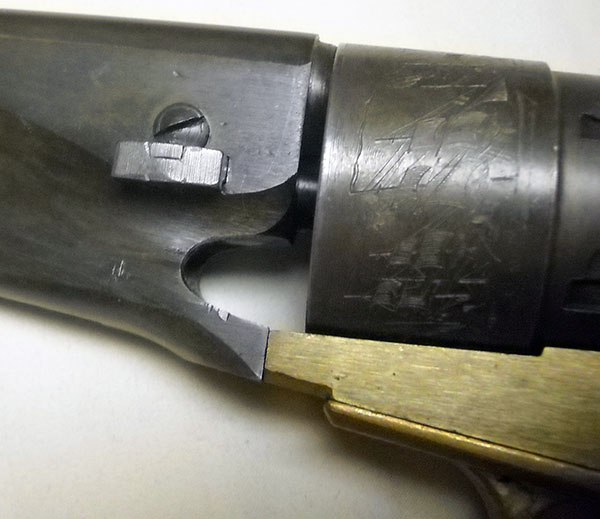
This key has a spring tab on the other side, and if you fiddle with it with a pair of needlenose pliers and a punch, you can work it out of the slot.
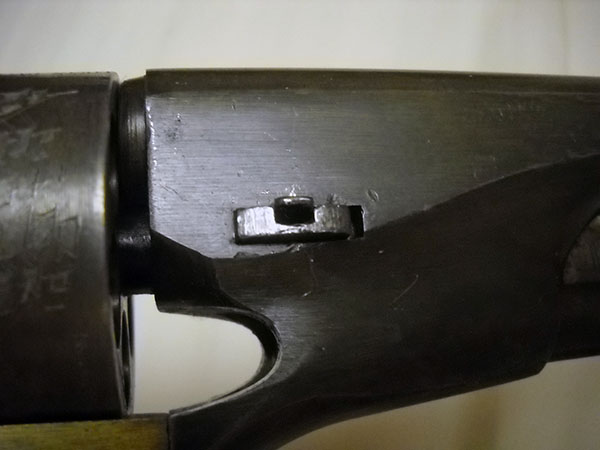
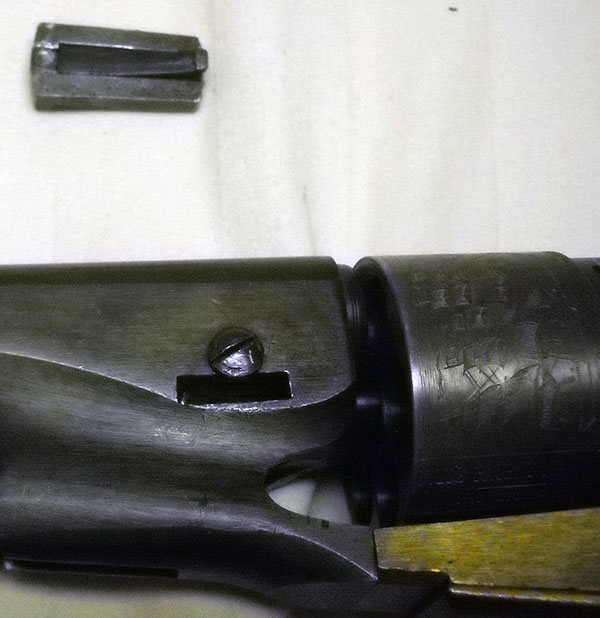
Once the key is out, you can pull the barrel assembly straight off the front of the frame.
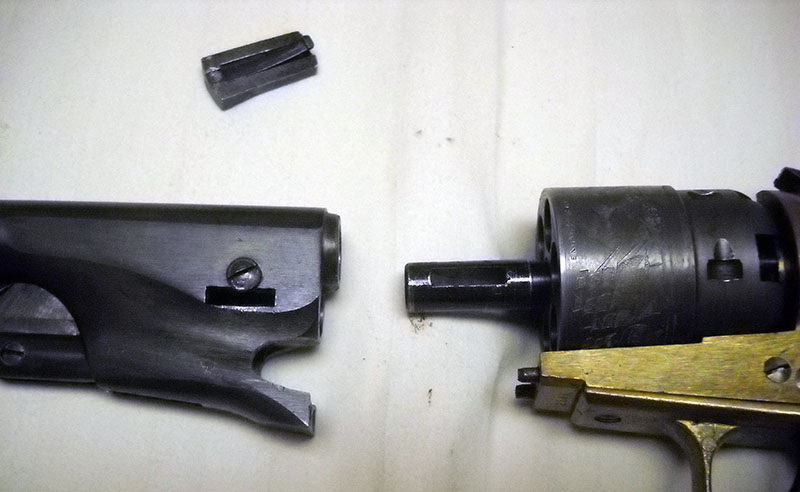
The cylinder then slides forward off its axis pin, and there's your field-stripped Colt.
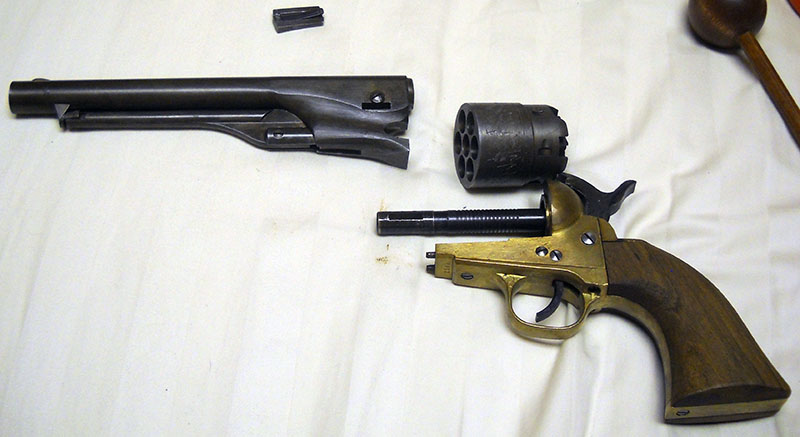
(That wooden object in the upper right is a ball starter for muzzleloading rifles, which also makes a handy hammer for tapping out the disassembly key once the spring latch is started. It's all about field expedience with these things!)
A shot of the back of the barrel assembly, once removed, provides a good view of (from top): the forcing cone (the interface between barrel and chamber), the hole for the cylinder access pin, the loading rod's plunger, and the holes for the two locating pins on the frame that align the whole thing when assembled (which you can see at the bottom of the shots showing the hand at work).
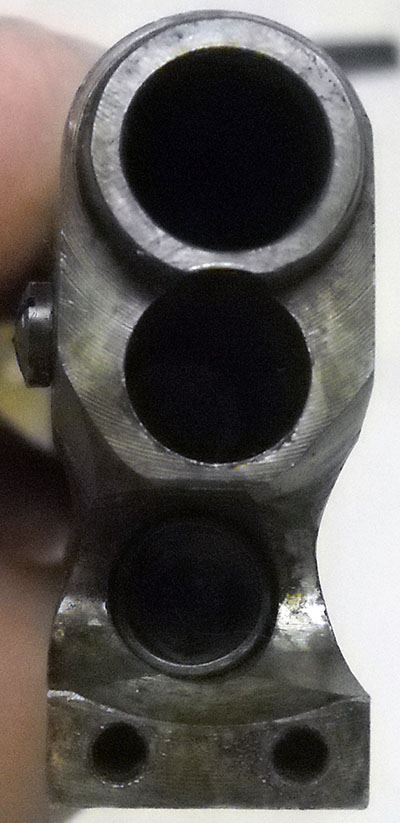
This entry was a bit of a trip down Memory Lane, as taking the CVA apart reminded me of putting it together in the first place. CVA's percussion revolvers used to be offered as kits, to be assembled and finished by the buyer. My father and I bought this one as a present for my grandfather, many years ago, and Gramp and I put it together over the course of a Christmas vacation. I really need to give it a thorough scrubbing and then take another pass at it with some cold blue. It looks fine in person, but the flash in some of the photos really brings out the thinness of the finish on the steel parts. (I'm not sure why the flash makes some parts, particularly the loading plunger, look rusty; in real life they don't appear to be.)
The 1849 Pocket repro also pictured above came fully finished, and apart from a serial number and "Italy", doesn't have any noticeable markings. "Italy" doesn't narrow things down very much, as, for whatever reason, most of the Western-themed black powder reproduction firearms on the market nowadays are Italian-made. It's a nice little gun, though I have to say I would hesitate to carry any loaded percussion firearm in my pocket. :)
Colt's 1851 Navy and 1860 Army revolvers remained popular well into the cartridge era. Their 1873 Single Action Army cartridge revolver is famous now, and rightfully so, but at the time they were quite expensive and the earlier percussion models still worked well. People didn't abandon them right away just because something new and more efficient had come along. There were a variety of cartridge conversions available for them, leading to the amusing state today whereby "1851 Colt Navy cartridge conversion" repros are now available that were never percussion-fired to begin with. (And because these use cartridges, they have to be handled like any modern firearm legally. In most US jurisdictions, new-made black powder firearms have the same legal status as the original antique versions, but only if they use loose powder. I guess the logic is that no one is going to have the time to go on a rampage with a muzzle-loading firearm.)
--G.
¹ Note that actual black powder is pretty rare nowadays. In addition to being messy, dirty, corrosive, and generally an unholy bitch to clean up after, it's not terribly shelf-stable, and as such is difficult and can be dangerous to store for long periods. It's also illegal to handle and transport without a special license. Most "black powder" shooters today actually use a modern substitute like Pyrodex® (manufactured by Hodgdon; other black powder substitutes are available), which is much safer, about a million times easier to clean up after, and is formulated to be volume-equivalent to any given charge of black powder.